Table of Contents
- LinkedIn surpassed Twitter/X as the top social platform for journalists, making it a key platform for PR relationship-building in 2025.
- Email remains the dominant marketing method (96% preference), despite a slight increase in DM-based outreach.
- Journalists now prefer exclusives over original research, signaling a shift in what drives coverage.
- Providing access to credible sources is more valuable than offering story ideas or data alone.
- Irrelevant pitches are on the rise, with 47% of journalists rarely receiving relevant outreach.
- Pitch volume is up, but journalist response rates are down.
Muck Rack and Cision dropped their yearly “State of” reports in June 2025.
Both studies interviewed similar audiences: Muck Rack’s “State of Journalism,” based on 1,890 journalists from the U.S., UK, Canada, and India, and Cision’s “State of the Media,” based on 3,126 journalists worldwide, providing an in-depth look at the evolving challenges and preferences of journalists.
I’ve examined both pieces closely, compared them to previous years, and analyzed their differences, and a story is starting to emerge.
Make no mistake, challenges lie ahead for all PR pros. We may have already noticed it in things like declining open rates or placements.
However, by understanding how the PR industry is evolving, we can make strategic plays to get ahead of these obstacles.
So, here are the major PR trends in 2025 based on Muck Rack and Cision’s reports (supported by our own data findings), and how you can use them to earn coverage and build relationships with journalists.
Note: In some cases, the Cision and Muck Rack reports featured repeat questions each year, allowing me to track changes in trends year over year. In those cases, it’s evident in the graph, but I’ve also noted it in the citations.

1. Social media is less critical to journalists for producing work, but it is still crucial for promoting their work
Social media is an integral part of the media industry. And while journalists definitely use it in their day-to-day workflows, there are some changes in how they use it.
According to Muck Rack, last year, the number of respondents who said social media is very important for producing their work was 33%; in 2025, it decreased to 23%.
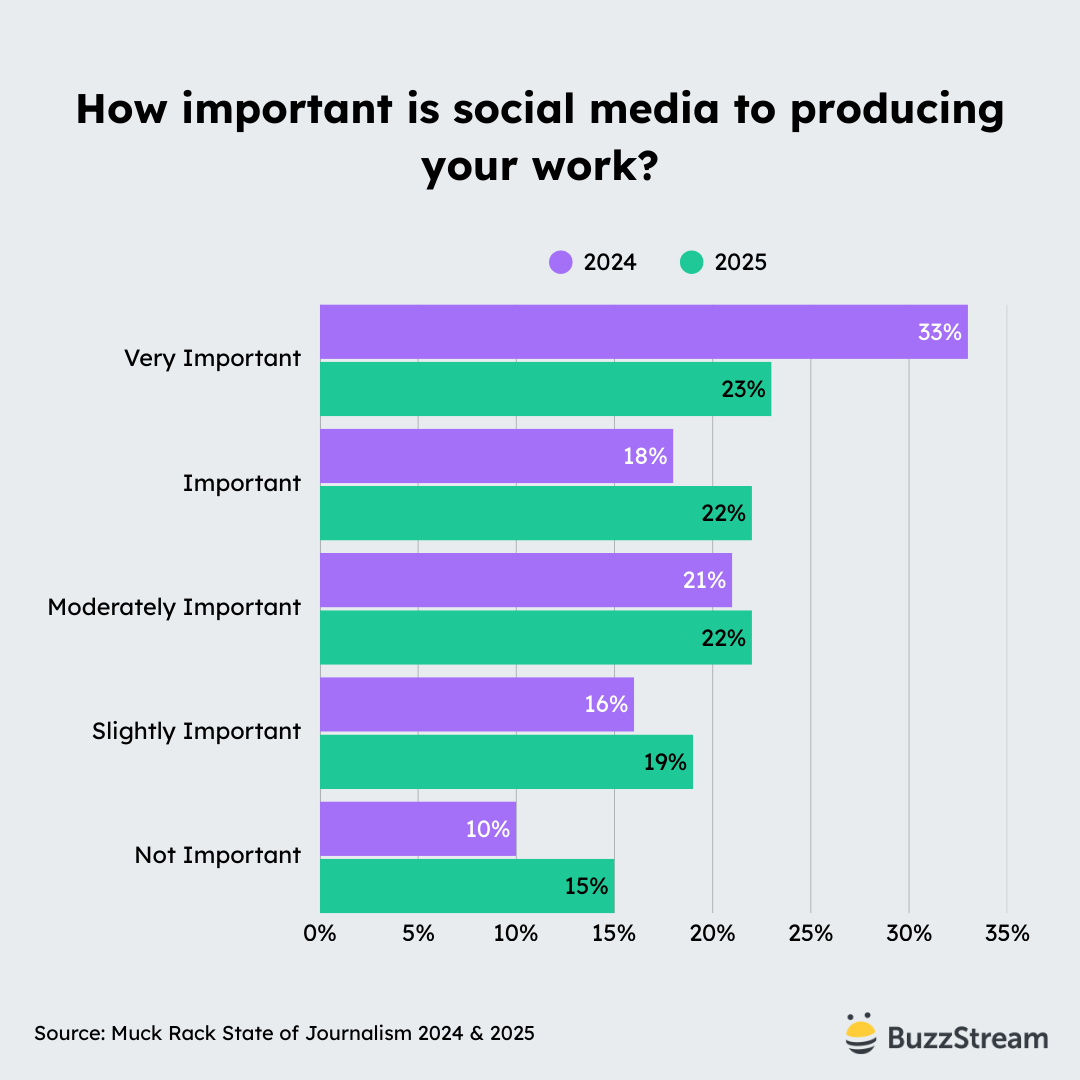
Now, compare that to how journalists view the role of social media for promoting their work, and you’ll notice that it’s still very important (albeit a few percentage points down).
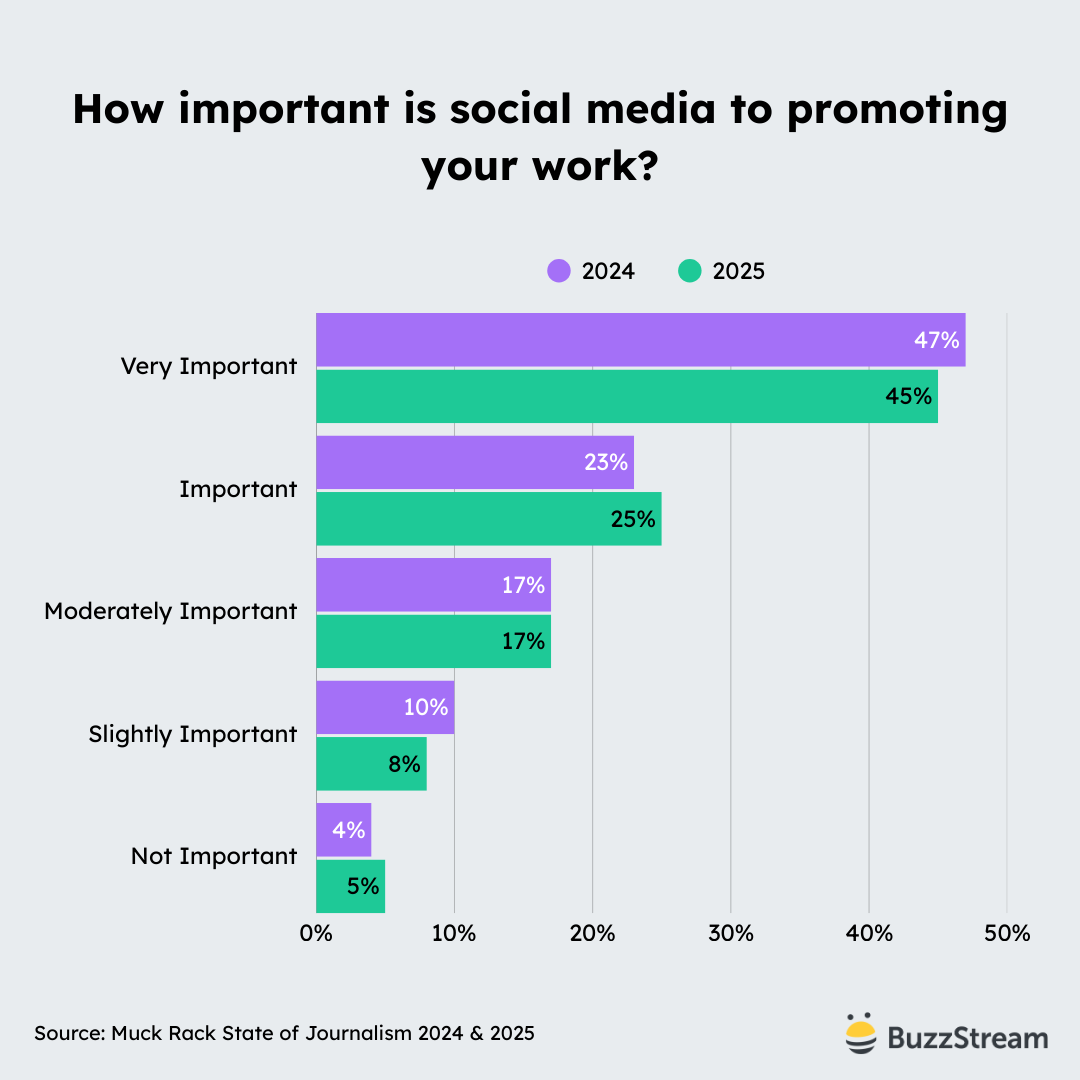
This highlights the evolving nature of media consumption.
The Reuters Institute Digital News Report showed that social media and video networks surpassed TV and online news sites for the first time ever.
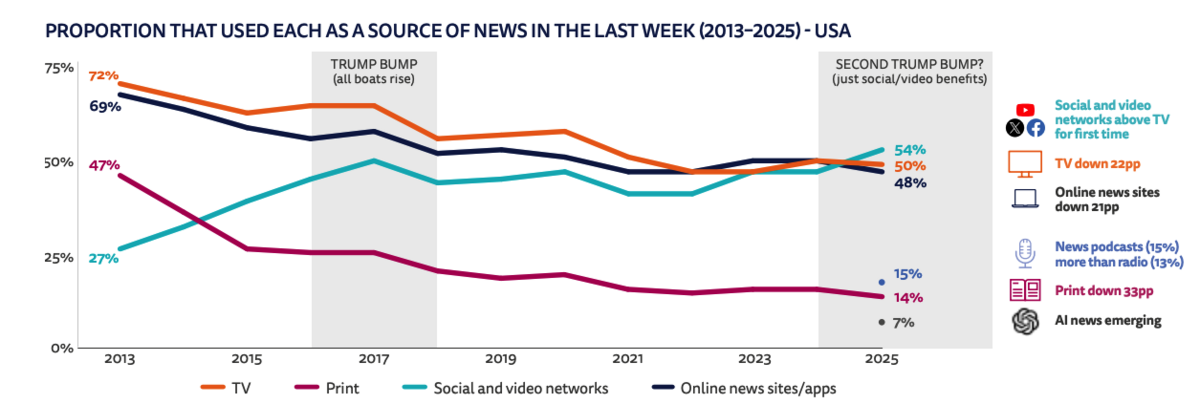
So, while social media may not be where journalists go to get their news, it is where they go to promote their stories and get them in front of readers.
With so much AI-generated content and misinformation on social media channels, it’s clear to me why journalists may be hesitant to use those platforms for producing stories.
What does this mean for PR pros?
Engaging with journalists on social media is a great way to establish and nurture relationships. Like, share, and comment on their content.
This is something PR pros Britt Klontz and Jaclyn Lambert both spoke about on our podcast, here’s a clip below (start at ~44 minutes):

Britt says, “…if you can go out of your way to share their stories, journalists love that.”
So, which platforms should you use to connect with journalists? Let’s go into that next.
2. LinkedIn seems to be the most valuable platform for journalists
According to Muck Rack, LinkedIn is the most valuable social platform for journalists in 2025 (28% vs. 22%).
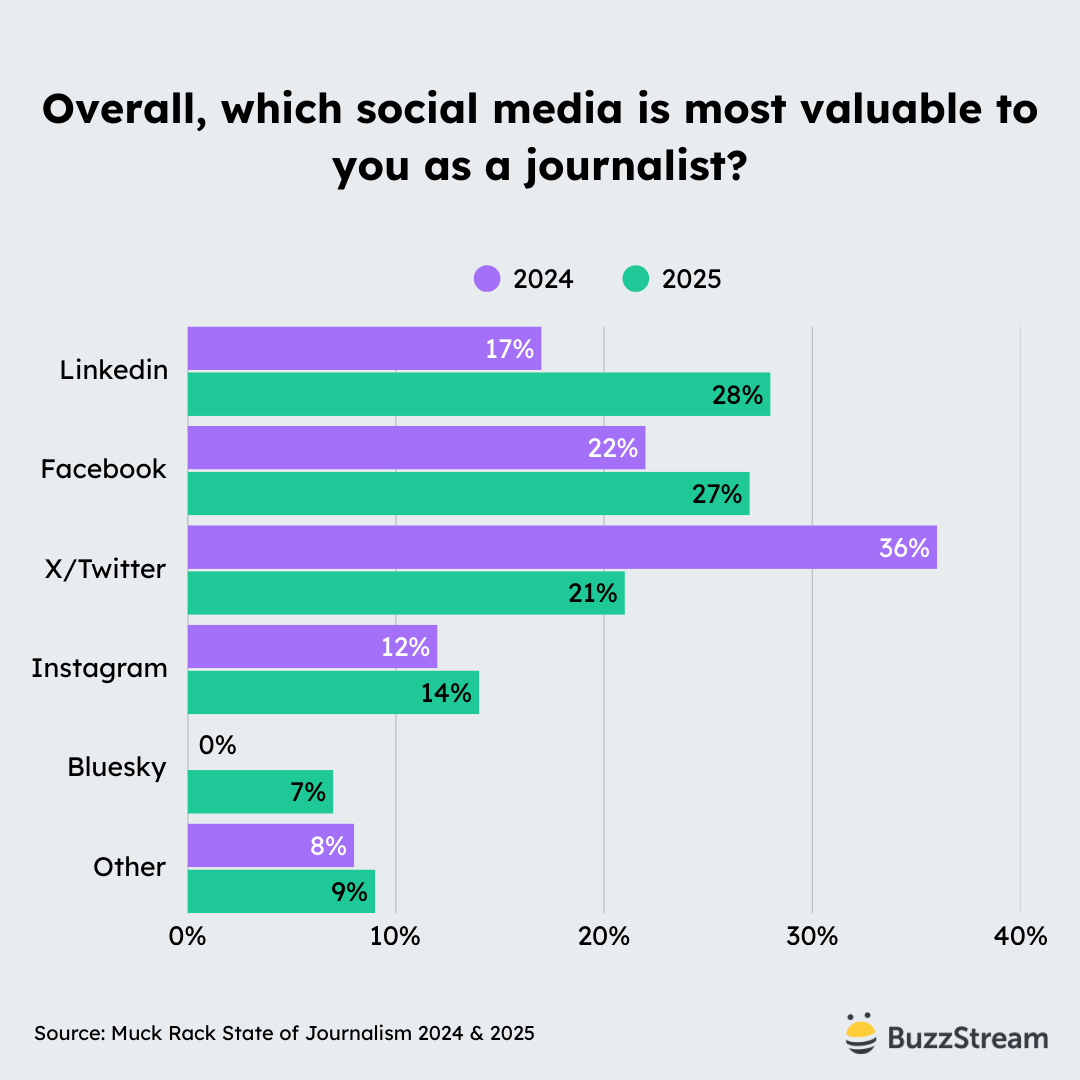
Linkedin “value” increased almost 64% last year and surpassed Twitter/X.
Twitter/X dropped from 36% to 21% in 2025.
Supporting Muck Rack’s findings, Cision reported that LinkedIn was the most frequently used in 2025 (59%), followed by Facebook (53%).
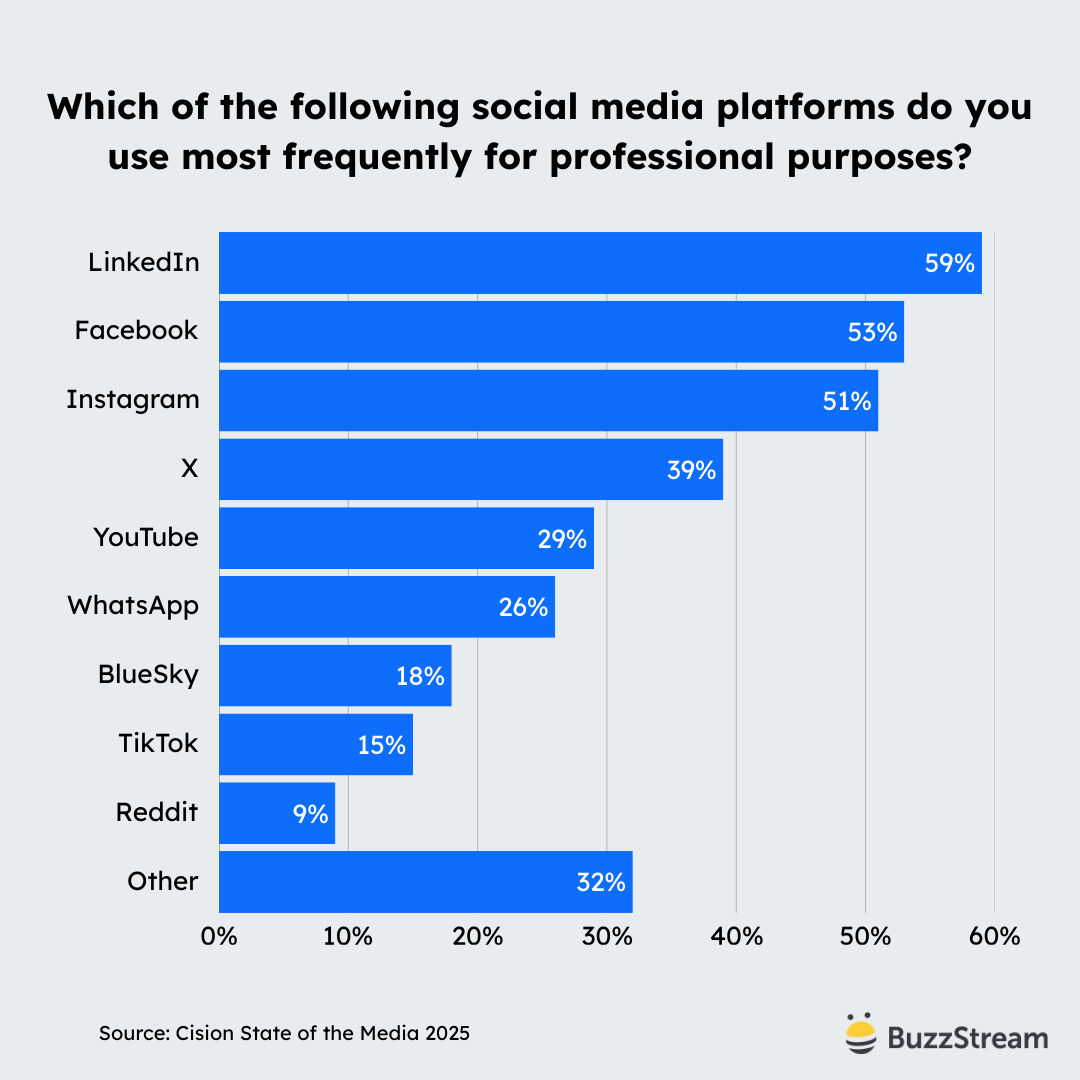
A sub-takeaway for me in this section is that despite all of the fanfare, it doesn’t seem like BlueSky is the platform that all journalists would migrate to as some stories said they would:
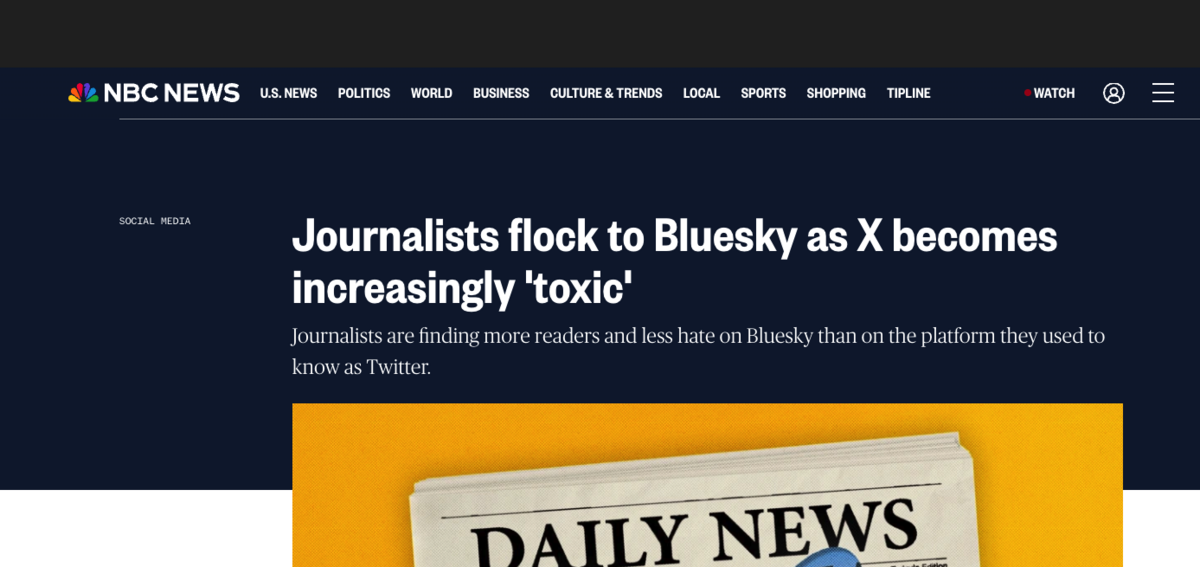
While it definitely seems like a less toxic environment overall, Bluesky only grew to 7% in 2025, according to Muck Rack, making it the 5th most valuable platform for journalists.
(For Cision’s report, it’s 7th place with 18% of users saying it’s used most frequently.)
What does this mean for PR pros?
LinkedIn is the journalist tool of choice overall, so it makes sense to invest some time developing relationships with journalists there.
Neither study provided industry-specific breakdowns, so there may be some industries, such as home decor or food, that skew more towards a visual medium like Instagram.
What I don’t want you to take away from this, however, is that interacting on social media means pitching.
Let’s get into that next.
3. Email is the number one way to pitch journalists
According to Cision, email is the primary method journalists prefer to receive pitches (96%).
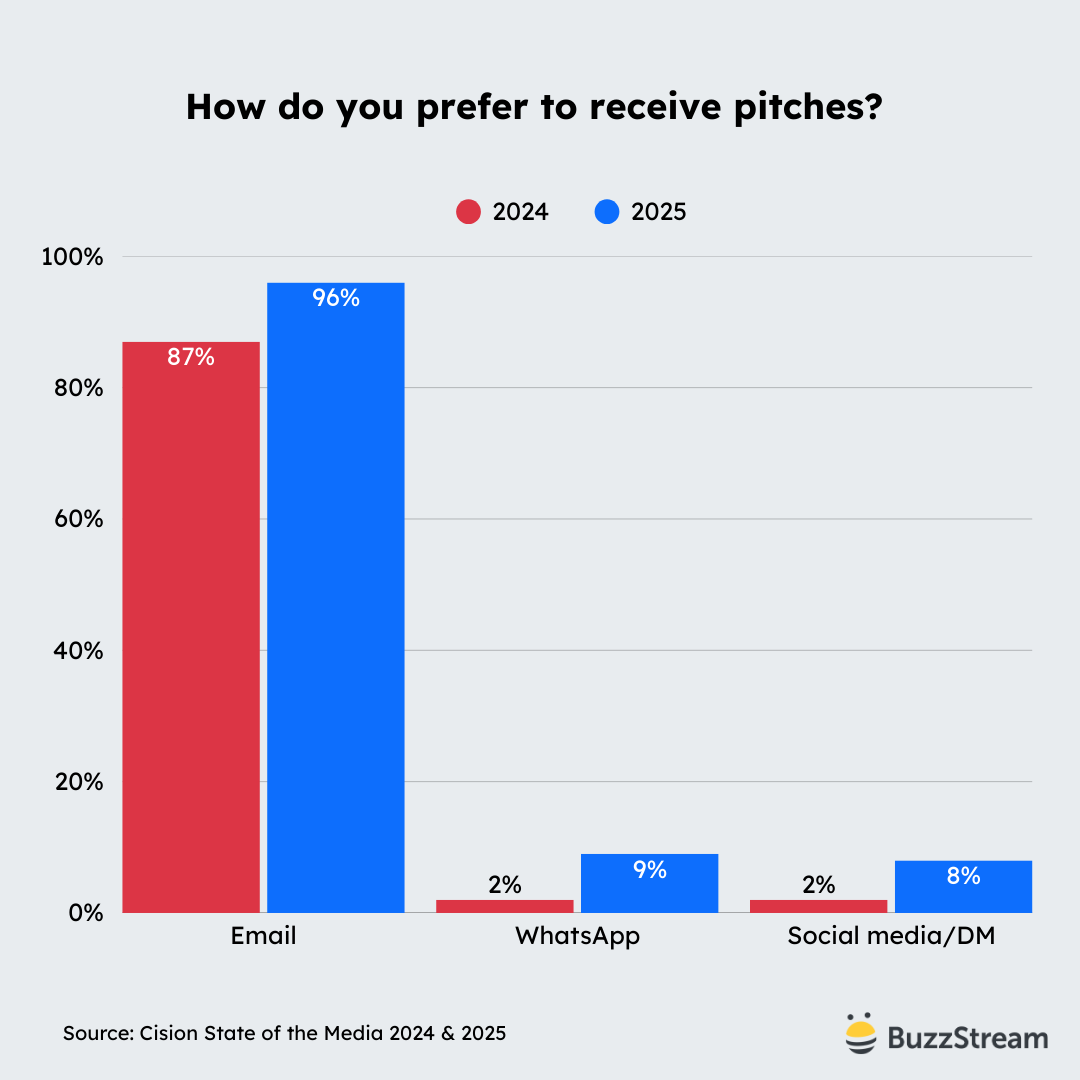
This email preference has grown since 2024, when it was 87%.
There was a slight increase in social media/DM pitch preference from 2024 (2%) to 2025 (8%), but the overwhelming majority still want to see a pitch via email.
Muck Rack’s study backed this up, showing that 62% of journalists prefer to be pitched via 1:1 email (based on the past four years of journalist surveys.)
What does this mean for PR pros?
Although there’s a lot more competition in the space, pitching via social media doesn’t seem to be an alternative.
Use social media to build relationships and get on a journalist’s radar.
For instance, I’ve been in touch with Press Gazette editors from time to time to pitch them things. But I also like to reshare stories they’ve produced:
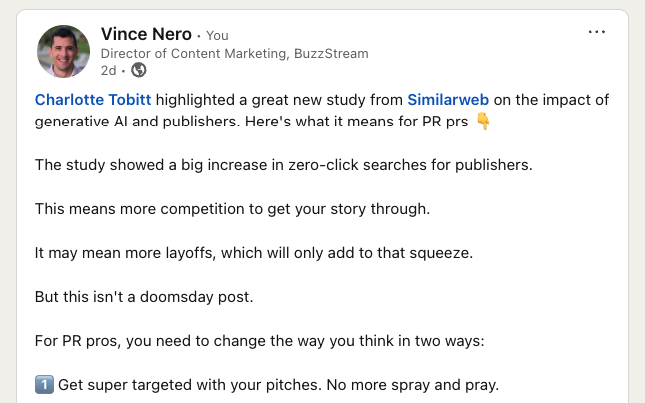
But this doesn’t mean I’m going to pitch through social.
Building relevant media lists and sending personalized pitches to journalists is the best way to cut through the noise in 2025.
Let’s dig into some more PR trends to understand what journalists want (or don’t want) out of your email pitches.
4. Journalists prefer exclusives over original research reports
Cision’s study found that journalists prefer news announcements or press releases 72%.
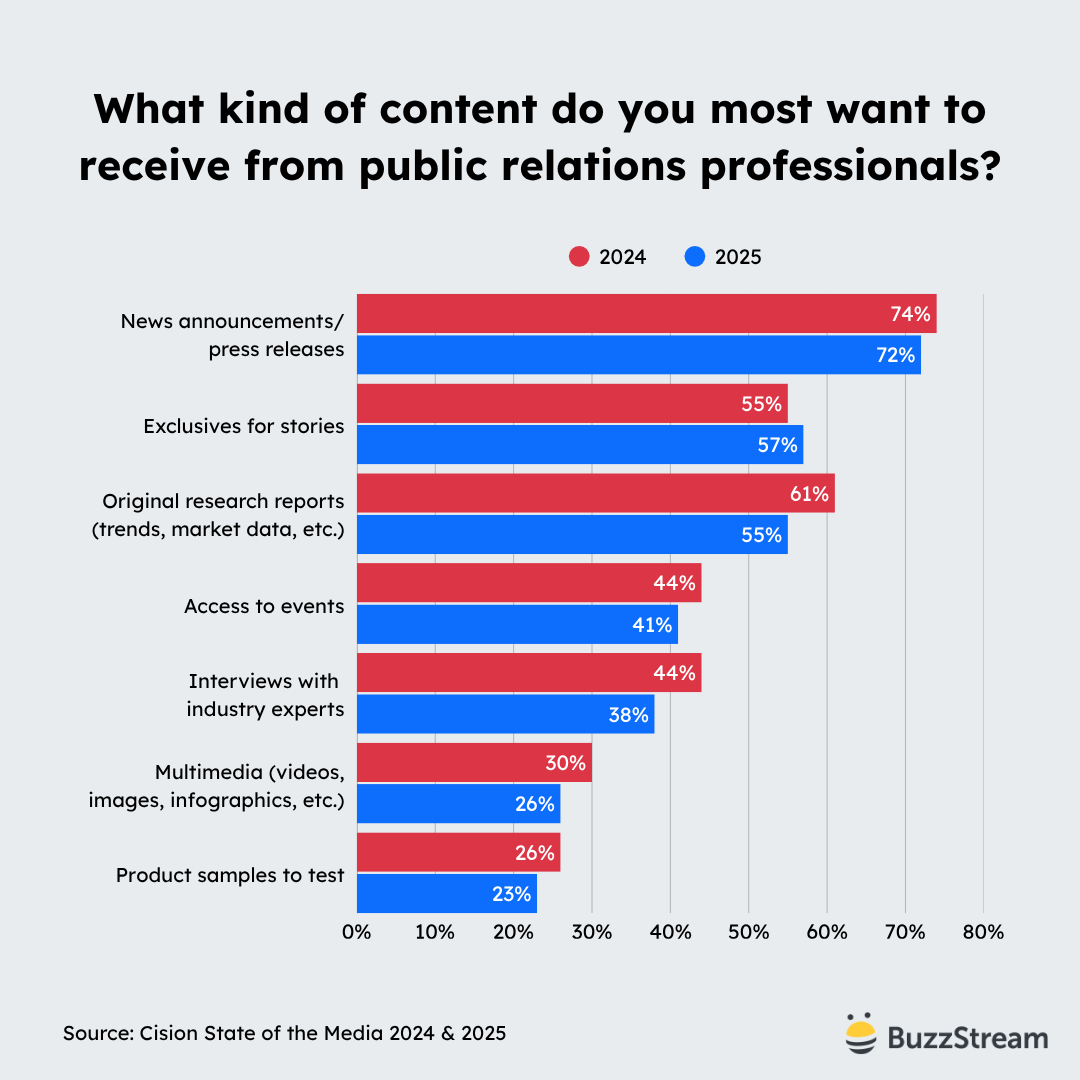
However, the surprise for me here is that the preference for exclusive stories (57%) overtook ‘original research reports,’ for the first time this year.
What does this mean for PR pros?
Exclusives might be the best way to cut through the noise that journalists feel is cluttering their inbox.
We found that to be the case with our subject line study. Subject lines with the term “exclusive” in them outperformed ones without “exclusive” in both open rates and reply rates.
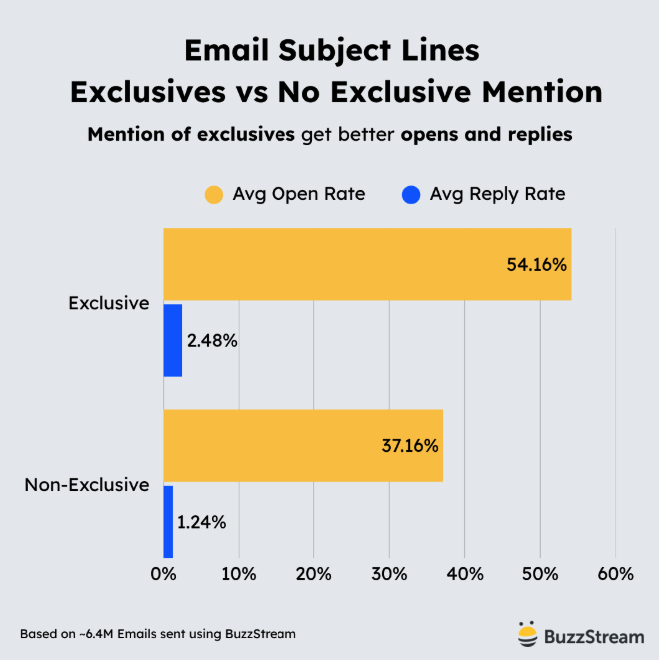
I also believe that pressures caused by AI Overviews and low readership are forcing journalists to look for stories that will drive traffic.
And exclusives might be a good bet (given your story is indeed a good one).
The next trend is another way to provide value for a journalist.
5. Journalists want access to your sources
According to Cision’s report, journalists most appreciate how PR professionals connect them with relevant sources (63%) and provide access to people and places (57%).
This access trumps story ideas (43%) and exclusives (39%).
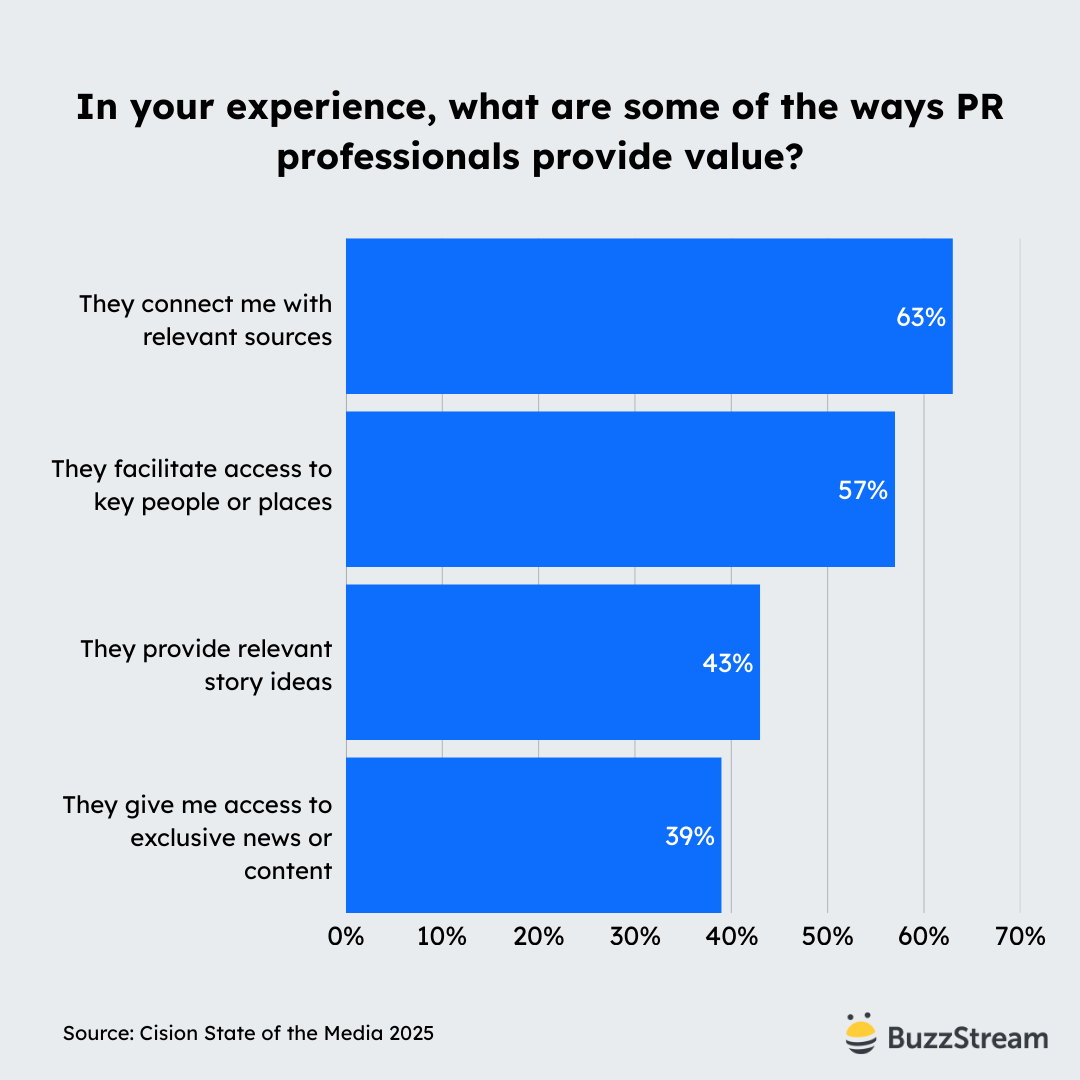
Muck Rack’s study found a result very similar to this in two separate places in their report. Aside from relevant pitches (66%), which we’ll discuss in the next trend, journalists said they most wanted interview access to relevant sources (27%).
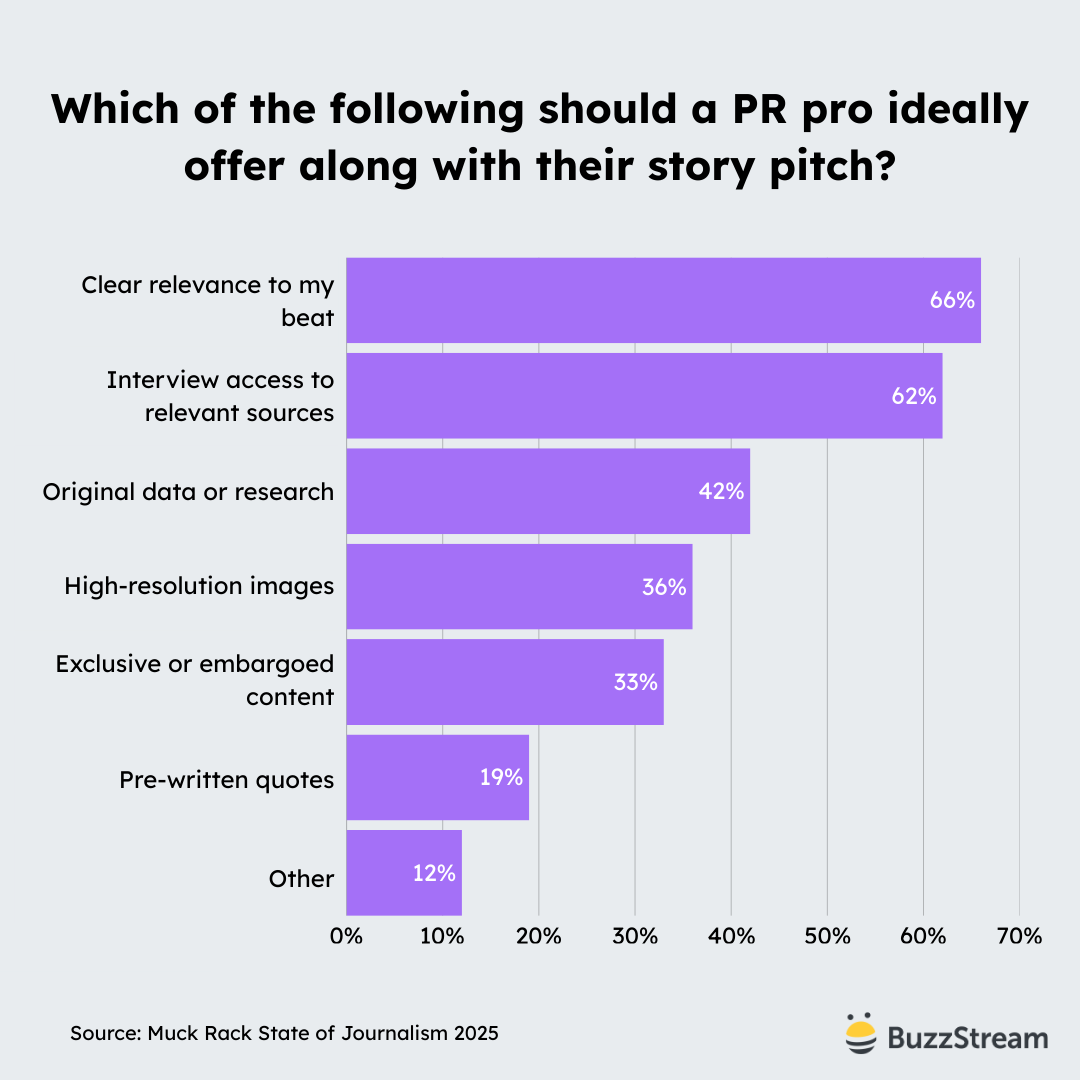
Interview access outweighs aspects like original data or even pre-written quotes.
In a subsequent question from the Muck Rack report, they inquired about the signals that indicate a PR pitch is worth a journalist’s time.
The first most crucial signal was once again relevance to their beat, and the second most important signal was that it offers access to a credible source.
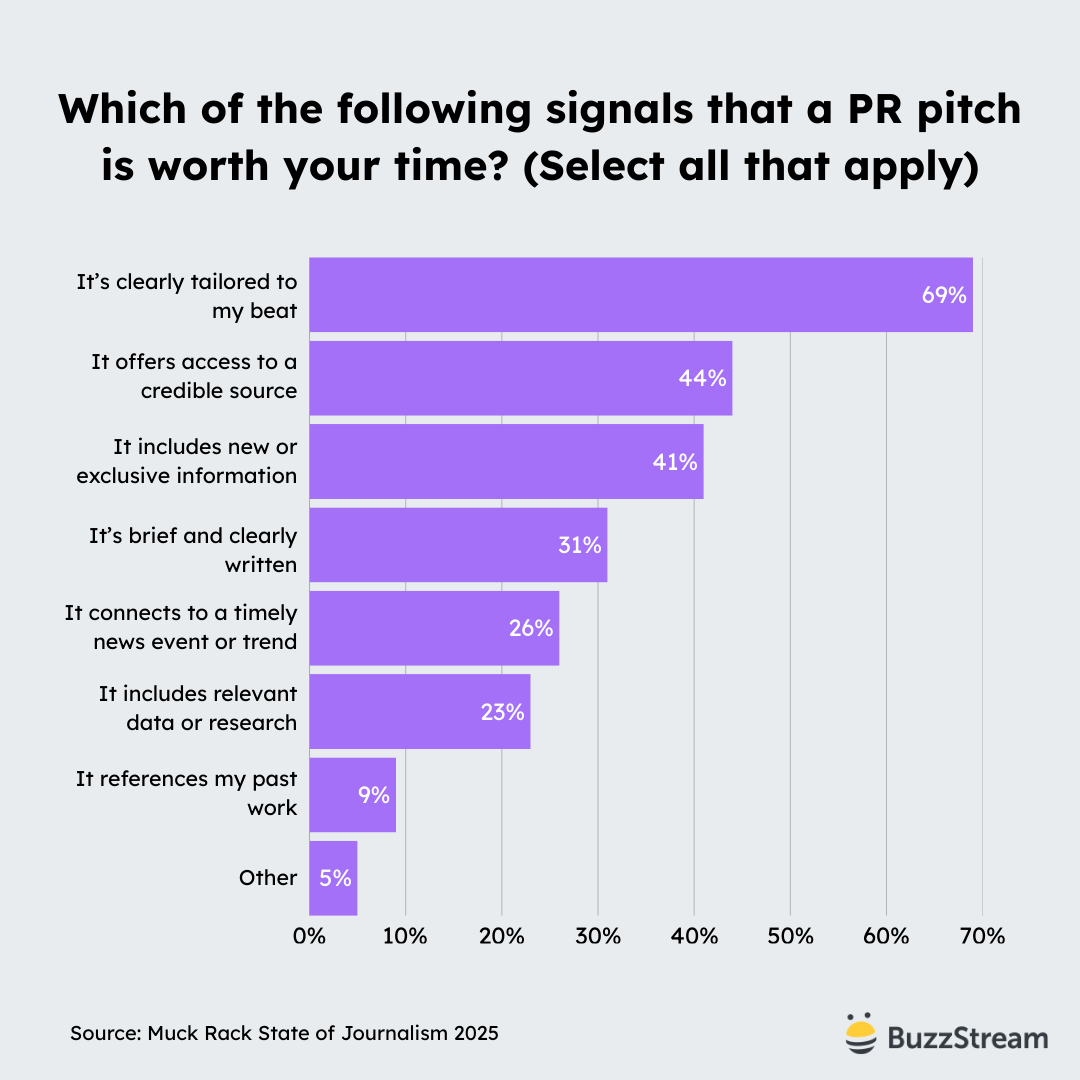
So, clearly journalists are in need of credible sources, which makes sense given some of the craziness surrounding fake experts getting cited in stories (covered here by the Press Gazette).
What does this mean for PR pros?
This means that you should be prepared to provide journalists with expert, credible sources for quotes.
We just did a deep study of journalist request platforms like HARO, SOS, and Qwoted.
Start by reading similar articles by your target journalist and understanding what kinds of sources they typically use.
For instance, here’s an article from Ana Teresa Sola on CNBC about the average first time home buyer age.

She cites:
- The Deputy Chief Economist of National Association of Realtors (NAR),
- The co-host of the Property Brothers
- A Senior Economist of Zillow
- A Chief Economist, CoreLogic
In some cases, journalists also want case studies (For those unfamiliar with the term in journalism—as I was when I started—a case study is more of a person who is impacted by the news story you are sharing.
So, if there was a story about a wildfire, trying to connect the journalists with a source that was personally impacted.
Now that we know what journalists want, let’s look at what we are up against.
6. Journalists are getting laid off, though it may be slowing a bit
According to Muck Rack, 37% of journalists reported layoffs or buyouts in 2025. This is consistent with their 2024 report.
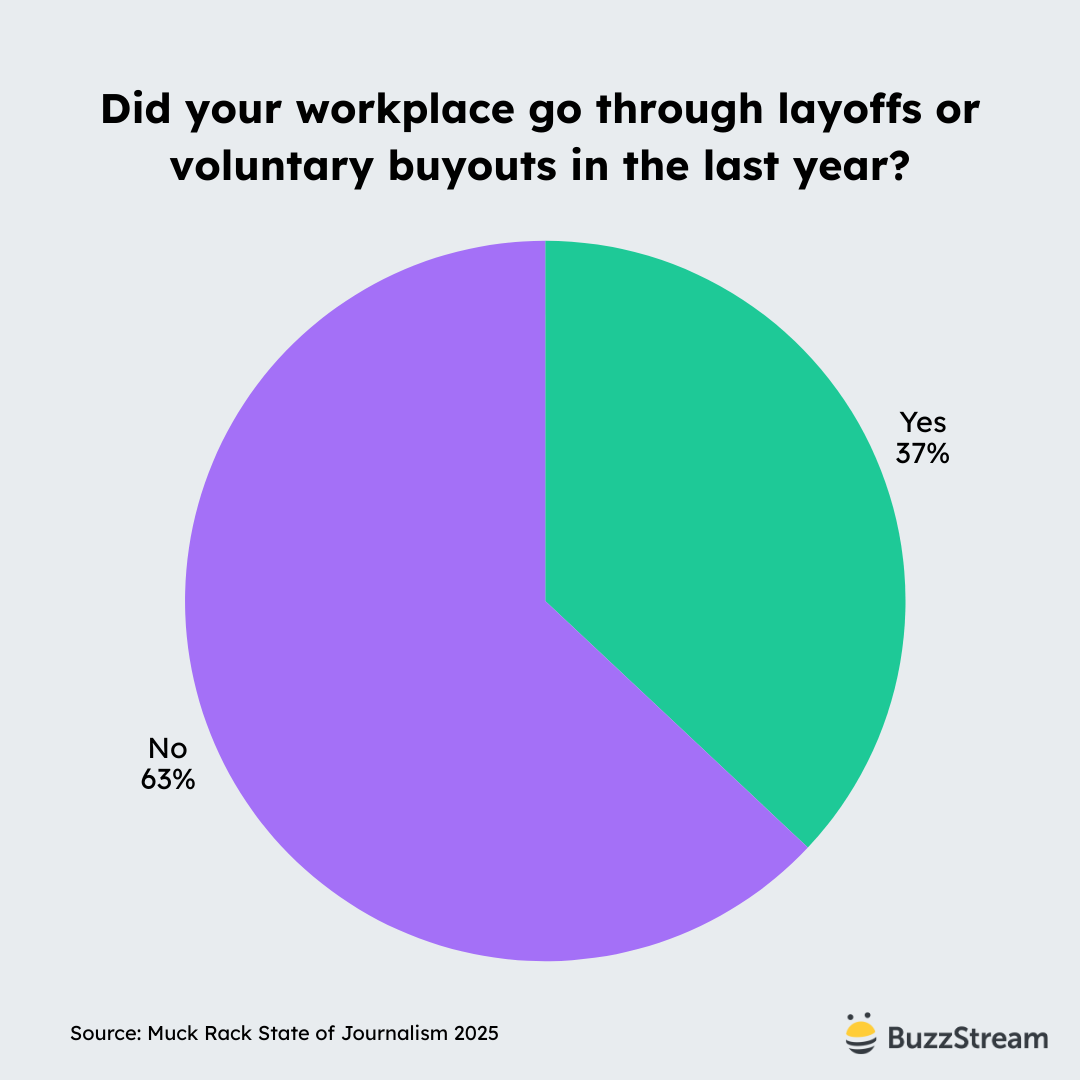
The Press Gazette has a fantastic ongoing report tracking job losses across the UK and the US.
Challenger, Gray, and Christmas also produce a monthly report of layoffs. And according to their report, broadcast, digital, and print news “has announced 1,139 job cuts so far this year, down 52% from the 2,397 cuts announced during the same period last year.”
Although these are estimates, the reported layoffs would look something like this:
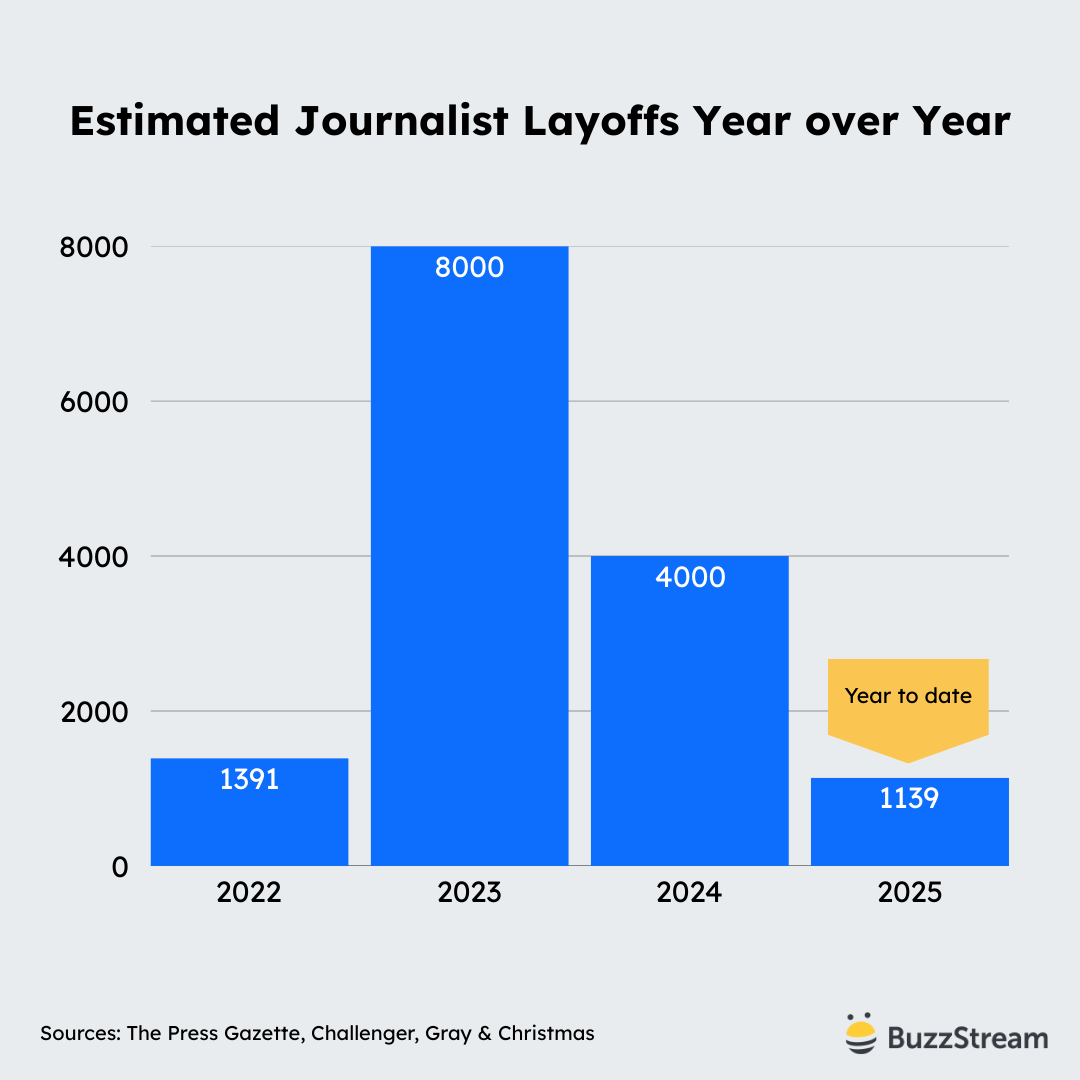
In many cases, journalists (freelance and in-house alike) are moving to platforms like Substack to write their own newsletters and cover stories without the pressures of a newsroom.
I often cite UK-based freelance journalist Rosie Taylor’s newsletter, Get Featured, but a quick search on Substack reveals a multitude of personal newsletters from other journalists.
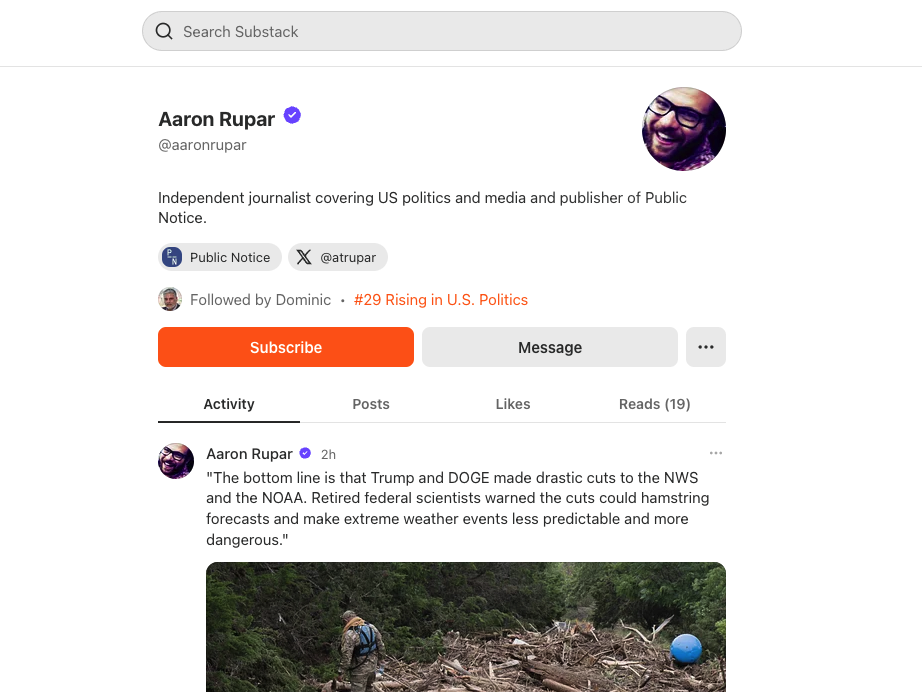
Supporting this, Muck Rack also reported that 34% of individuals independently publish news, commentary, or other content under their name or brand, outside of a traditional media organization.
If journalists continue to get laid off and/or news sites struggle for viewership and trust, I would expect more journalists to move to platforms like Substack.
When layoffs hit, the journalist pool begins to shrink. However, demand for PR and digital PR is at an all-time high according to Google Trends.
Many SEO and link building agencies are starting to move towards offering PR services.
What does this mean for PR pros?
It should be no surprise that the industry is changing and getting more competitive.
And the fix here is going to start sounding like a broken record: PR pros need to start thinking about how to cut through the noise.
Engaging and following journalists’ work on their Substack is a great way to get visibility and build relationships.
Just remember, don’t pitch via Substack. Email remains the #1 platform for journalists.
Focusing on quality pitches vs quantity is also key to success.
7. The number of pitches journalists receive has grown
There is an ongoing debate online about how PR professionals, especially in the digital PR space, should approach email outreach.
Some recommend casting a wide net, while others (like me) preach the hyper-targeted approach.
The result of casting a wide net is that journalists receive more pitches.
Muck Rack found that the number of daily pitches is increasing.
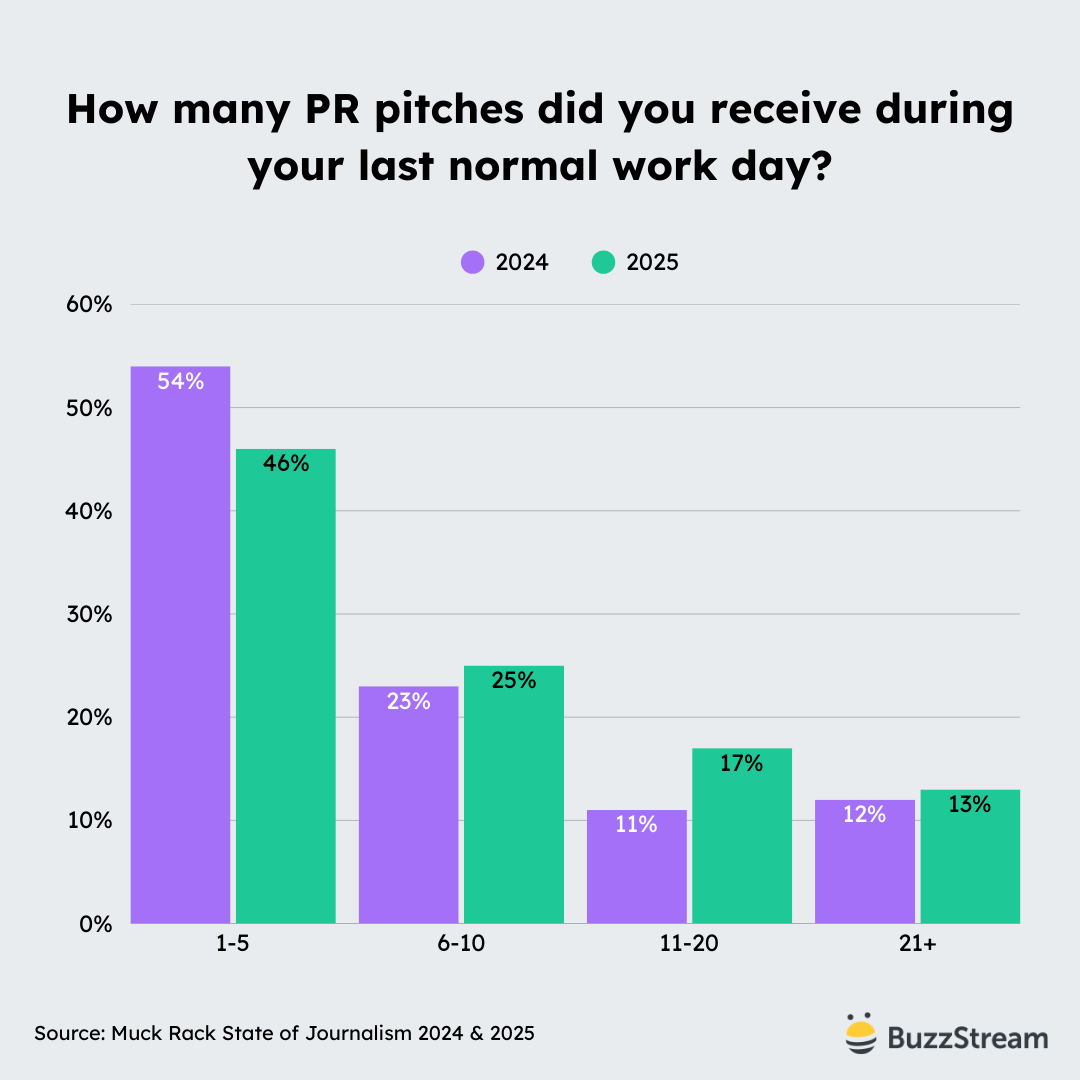
The 11-20 bucket is 6pp higher in 2025 than it was in 2024.
We can look to Cision’s data, which shows an increase in the weekly number of pitches in the 1-50 and 51-100 buckets.
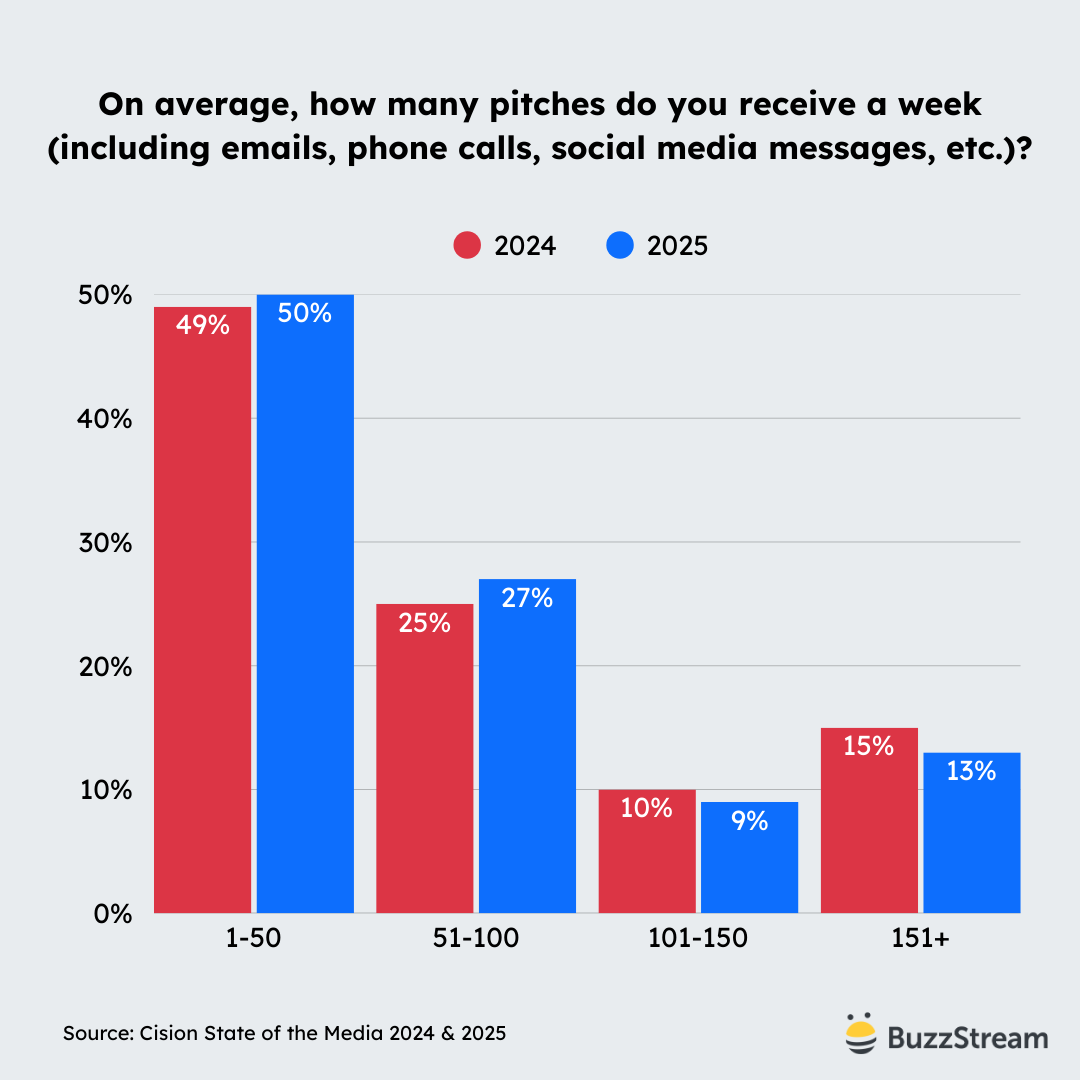
What does this mean for PR pros?
This means your job is becoming increasingly challenging every day. So, I recommend focusing on individual pitches rather than the bulk approach.
We’ve been publishing data-driven insights on pitching best practices that can give you a competitive edge, so be sure to subscribe to our newsletter for updates.
With the increase in bulk pitches, relevance is dropping.
Let’s get into that next.
8. Irrelevant pitches are increasing, adding to inbox noise
Frustratingly, it seems like journalists are still getting bombarded with pitches that don’t correspond to their beat.
Muck Rack found 47% seldom or never receive PR pitches relevant to what they cover.
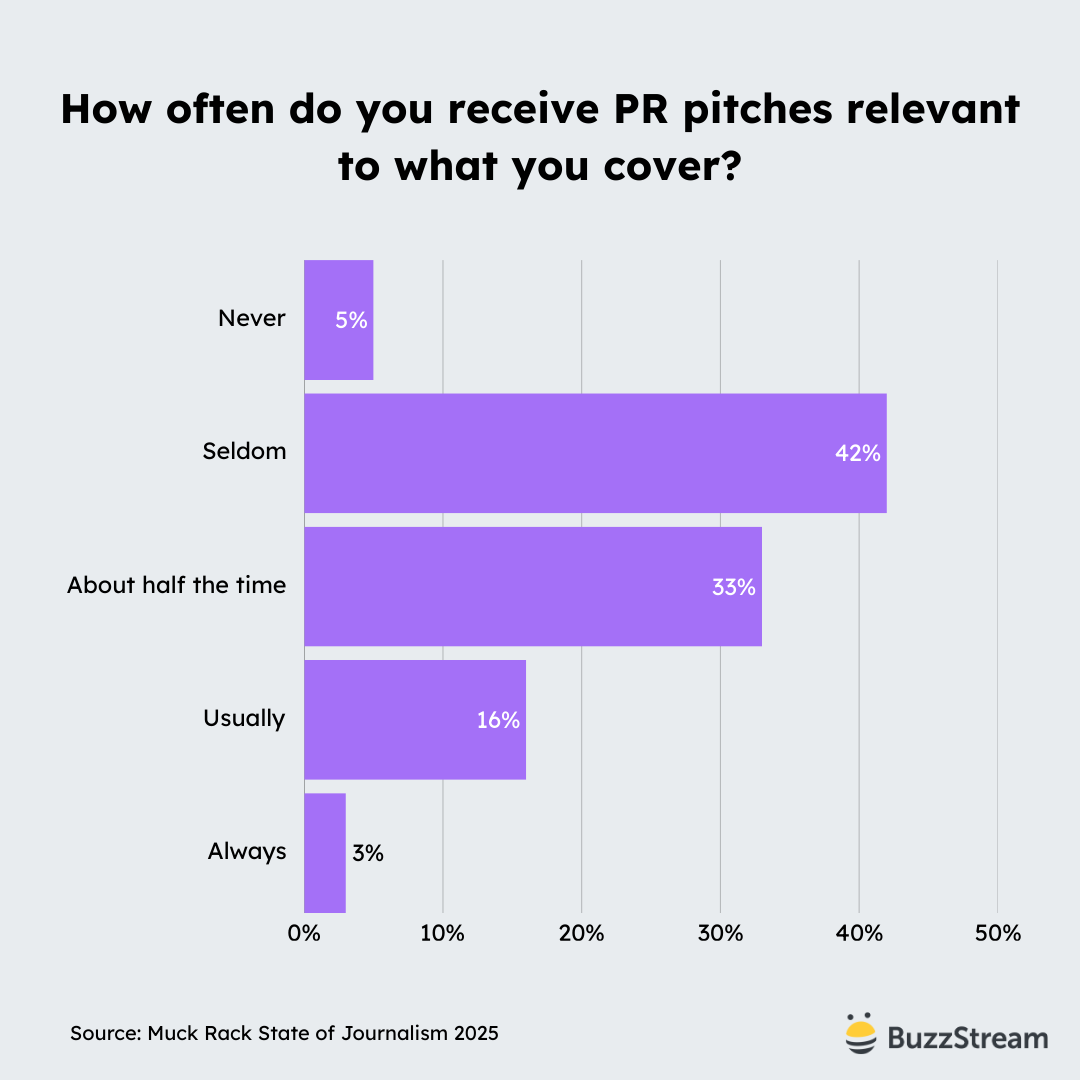
Just 3% always receive relevant pitches.
It’s mind-boggling to think that this is still happening when journalists have been so up front about rejecting pitches.
Consider these stats from both Muck Rack and Cision:
Cision found that the number one reason journalists block you is when they receive a pitch that is not relevant to their beat.
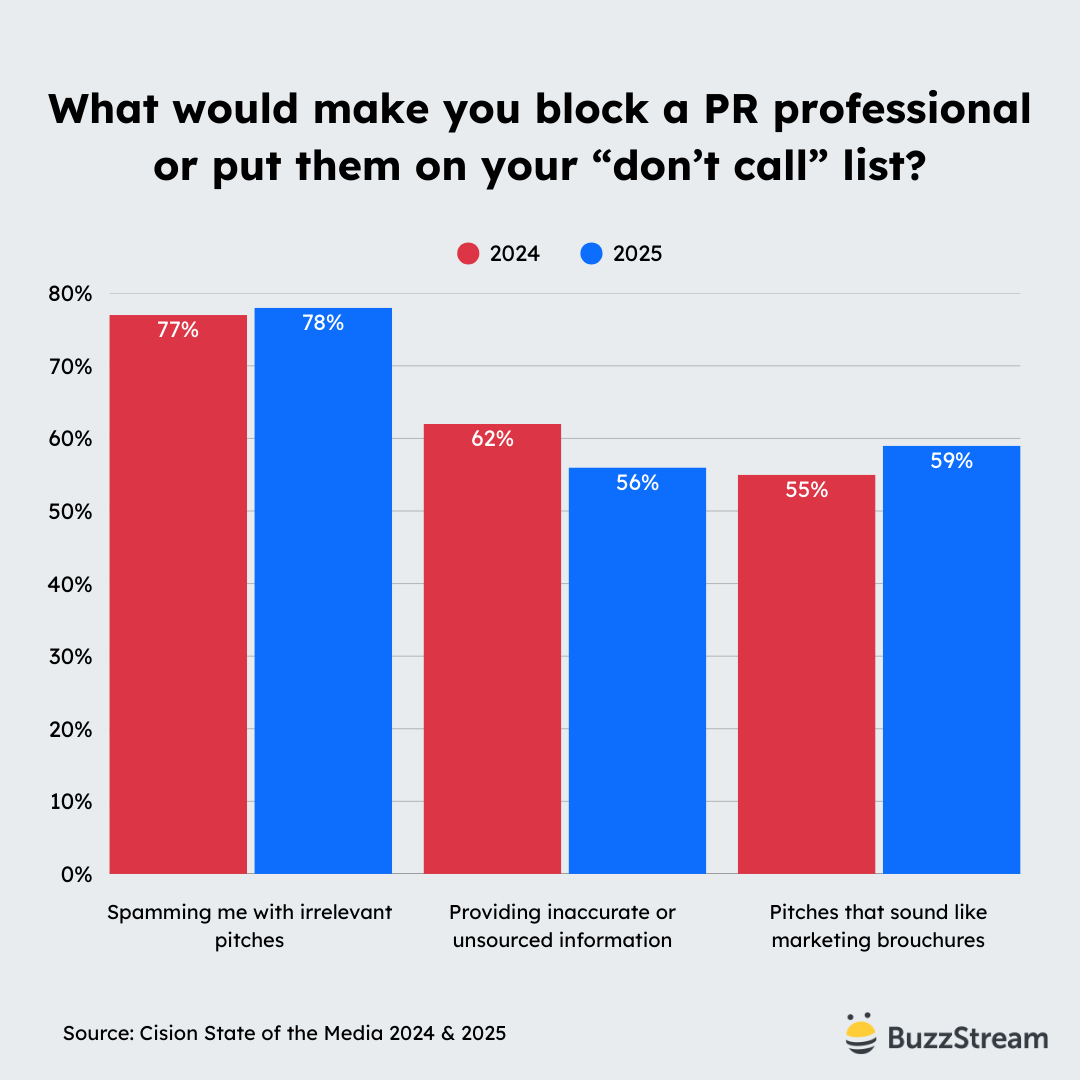
This has consistently been a major gripe since 2024 and has only worsened.
According to Muck Rack’s study, we can observe the same issues. The top reason for rejecting a PR pitch is when it’s not relevant to the coverage area.
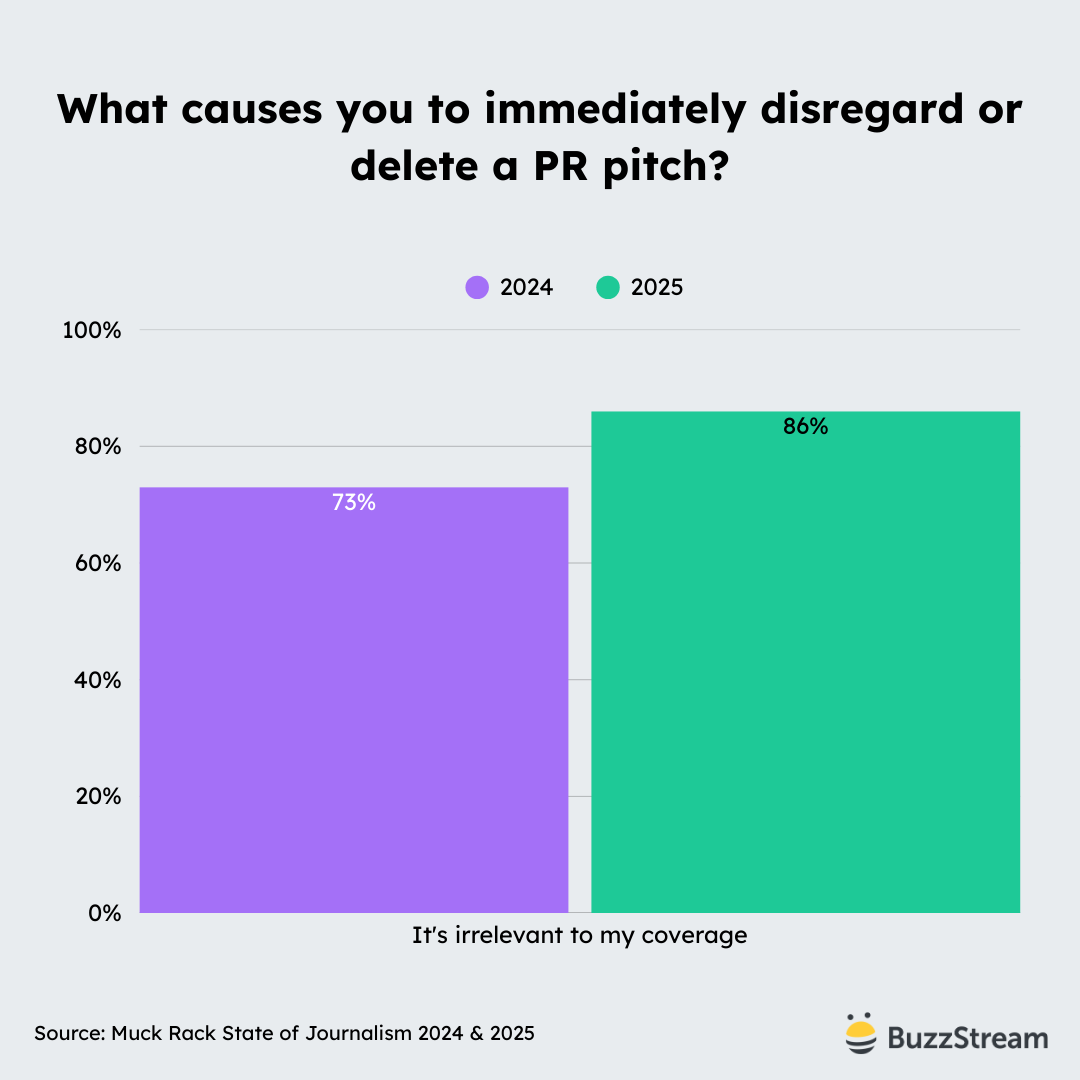
This issue has also become more pronounced in 2025, with an increase of almost 20%.
What does this mean for PR pros?
This means that PR pros need to check for relevance before sending their pitches, or they may face being ignored, blocked, or worse, marked as spam.
We created ListIQ to help PR professionals build relevant media lists more quickly and efficiently.
The flipside of this is that when you do send relevant pitches, it can help build a positive rapport with a journalist.
Even if the journalist doesn’t want to use your pitch, they might flag you for a subsequent story or quote.
When a journalist doesn’t respond, it doesn’t mean they aren’t reading your pitches.
This brings me to our last point.
9. Journalists are responding less
According to Muck Rack, the journalist response rate is dropping. 54% of the time, they seldom or never respond to a pitch.
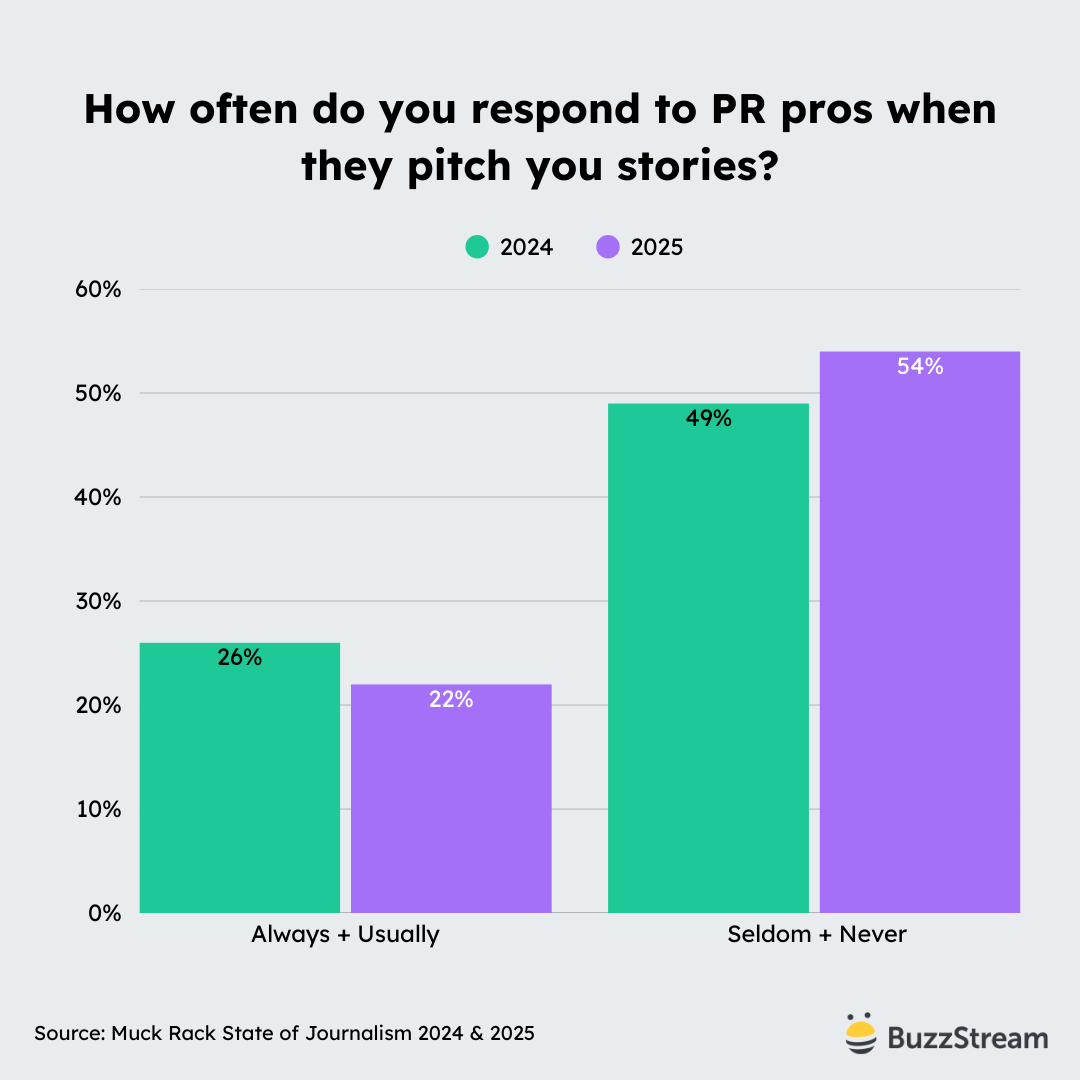
Is response rate everything?
Definitely not.
Sometimes a journalist may not respond even when they like and use your pitch.
But I think there is something else at play here. When examining Cision’s report, they presented this issue from a different angle.
When asked how often journalists receive media pitches that they’d like to cover but can’t due to factors such as time or resource constraints, Cision found that just 5% said it never happens.
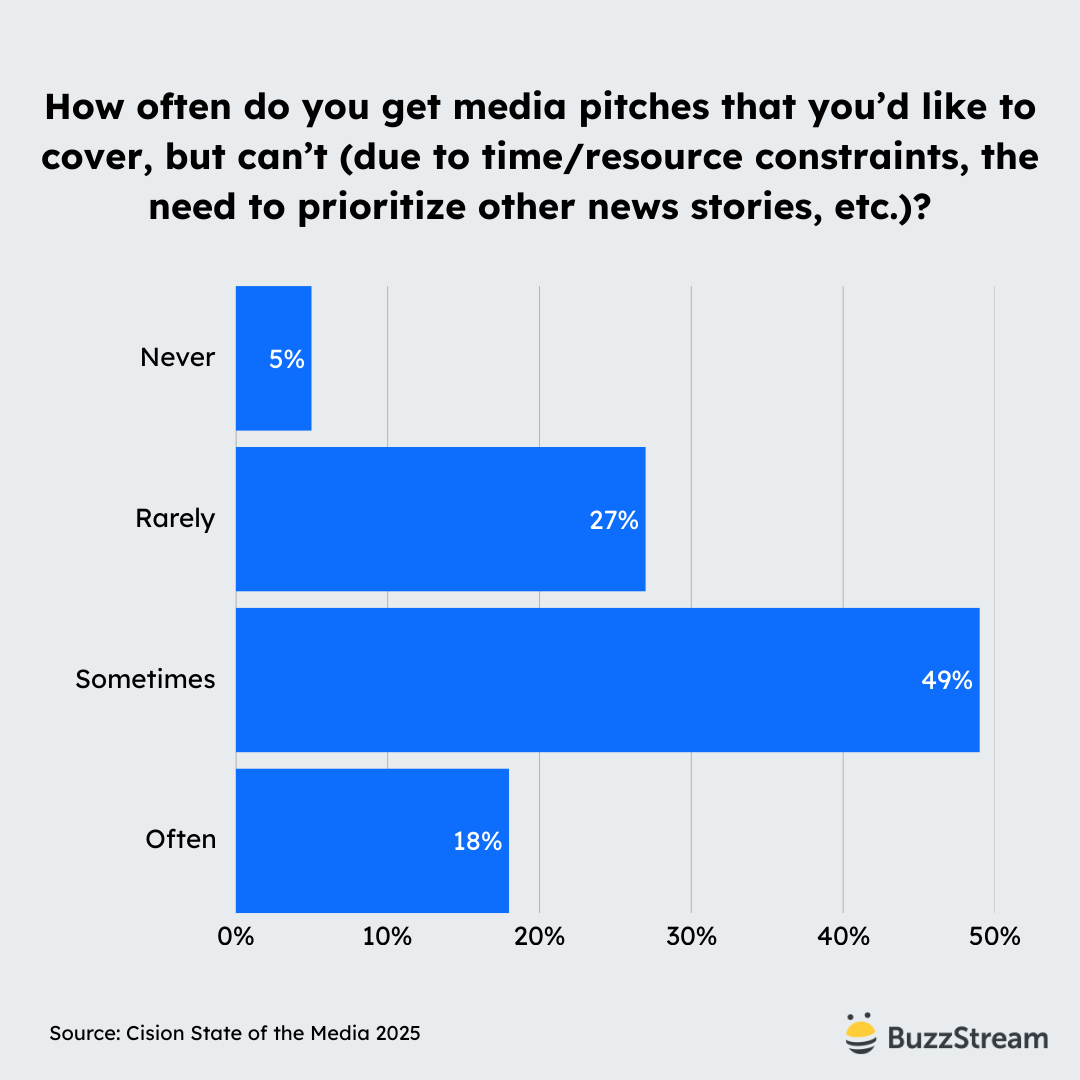
More than 50% of journalists report needing to sit on a story even if they like what you have to say.
What does this mean for PR pros?
I’ve long thought that if a journalist doesn’t respond after a handful of pitches, they most likely won’t ever respond.
And while this may be partially true, the data suggests that as long as your pitch is hyper-relevant to their beat (not to mention interesting), you still have a chance, no matter how many times you pitch.
So, it pays to be consistent and relevant, because if they can’t get you this time, they might the next time around.
10. The state of media relations in 2025 is shifting
The story here is clear.
Journalists are facing enormous pressure to maintain readership, particularly in the face of AI, misinformation, budget cuts, and other challenges.
The easy solution is to think that you need to pitch more.
But as we’ve seen from these trends, it’s more about providing value beyond a story or data.
Focus on highly targeted pitching, which you can do with our new media list-building tool, ListIQ, and use that to build meaningful relationships.
These relationships, whether personal or professional, can yield coverage, connections, and media mentions, helping to build your brand in ways that will enable you to succeed in 2025 and beyond.

 End-to-end outreach workflow
End-to-end outreach workflow



 Check out the BuzzStream Podcast
Check out the BuzzStream Podcast







